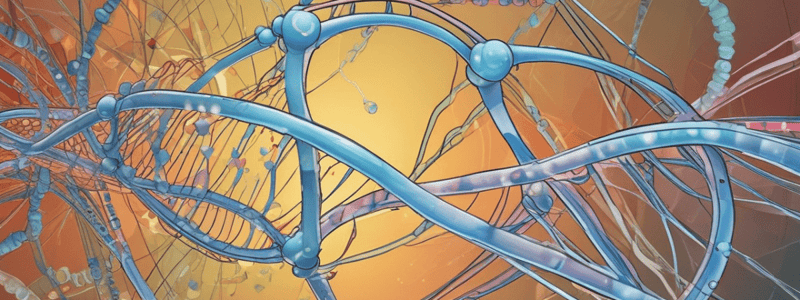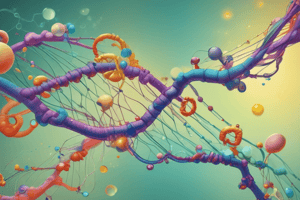Podcast
Questions and Answers
What is the purpose of RNA editing?
What is the purpose of RNA editing?
- To directly translate DNA into proteins.
- To make a large RNA molecule without any modifications.
- To remove and splice together exons and introns. (correct)
- To function as ribosomal RNA.
Which component is removed from the pre-mRNA during RNA editing?
Which component is removed from the pre-mRNA during RNA editing?
- Exons
- Tails
- Introns (correct)
- Caps
Why is it significant that a single gene can produce several different mRNA molecules?
Why is it significant that a single gene can produce several different mRNA molecules?
- It increases the protein degradation rate.
- It allows for greater diversity in protein functions. (correct)
- It prevents RNA molecules from being spliced.
- It ensures a backup copy of mRNA is always available.
What analogy is used to describe the editing of pre-mRNA?
What analogy is used to describe the editing of pre-mRNA?
Which of the following best describes exons?
Which of the following best describes exons?
Which type of RNA is primarily responsible for carrying genetic instructions from the nucleus to the ribosome?
Which type of RNA is primarily responsible for carrying genetic instructions from the nucleus to the ribosome?
What is the main function of ribosomal RNA (rRNA)?
What is the main function of ribosomal RNA (rRNA)?
What role does transfer RNA (tRNA) play during protein synthesis?
What role does transfer RNA (tRNA) play during protein synthesis?
In terms of RNA functions, how many different proteins can the subunits of ribosomal RNA (rRNA) potentially assemble?
In terms of RNA functions, how many different proteins can the subunits of ribosomal RNA (rRNA) potentially assemble?
Which nitrogenous base is found in RNA but not in DNA?
Which nitrogenous base is found in RNA but not in DNA?
Which RNA type would you most likely study to understand how genetic information is translated into a functional molecule during protein synthesis?
Which RNA type would you most likely study to understand how genetic information is translated into a functional molecule during protein synthesis?
What type of sugar is found in the backbone of RNA?
What type of sugar is found in the backbone of RNA?
In DNA, adenine pairs with which nitrogenous base?
In DNA, adenine pairs with which nitrogenous base?
Where is DNA typically stored within the cell?
Where is DNA typically stored within the cell?
What is the primary role of RNA in the cell?
What is the primary role of RNA in the cell?
What base does adenine pair with in RNA?
What base does adenine pair with in RNA?
What sugar does RNA use?
What sugar does RNA use?
What is the primary role of RNA in the cell?
What is the primary role of RNA in the cell?
Which nitrogenous base is found in RNA but not in DNA?
Which nitrogenous base is found in RNA but not in DNA?
In what structural form does RNA generally exist?
In what structural form does RNA generally exist?
What is the first step in decoding genetic instructions from DNA?
What is the first step in decoding genetic instructions from DNA?
What is one reason why enzymes can distinguish between DNA and RNA?
What is one reason why enzymes can distinguish between DNA and RNA?
What is the function of RNA polymerase in transcription?
What is the function of RNA polymerase in transcription?
Which of the following correctly describes promoters?
Which of the following correctly describes promoters?
What role do segments of DNA serve during transcription?
What role do segments of DNA serve during transcription?
How does transcription differ from DNA replication?
How does transcription differ from DNA replication?
Which base is found in RNA but not in DNA?
Which base is found in RNA but not in DNA?
What is required for RNA polymerase to start transcription?
What is required for RNA polymerase to start transcription?
Which of the following statements is true about the transcription process?
Which of the following statements is true about the transcription process?
During transcription, what is assembled using the DNA template?
During transcription, what is assembled using the DNA template?
Flashcards are hidden until you start studying
Study Notes
RNA and Its Role
- RNA (ribonucleic acid) is a nucleic acid that helps put the genetic code into action.
- RNA consists of a long chain of nucleotides, similar to DNA.
- RNA uses the instructions from DNA to direct the production of proteins, which determine an organism's characteristics.
Comparing RNA and DNA
- RNA and DNA are similar in composition, but they differ in three key ways:
- RNA uses the sugar ribose, whereas DNA uses deoxyribose.
- RNA is generally single-stranded, whereas DNA is double-stranded.
- RNA contains uracil instead of thymine.
DNA and RNA Roles
- DNA contains the genetic information of the cell and is stored in the nucleus.
- RNA is synthesized when the cell needs the products of a particular gene.
- DNA is like the architect's master plan, while RNA is like the blueprint.
RNA Synthesis
- A single DNA molecule may contain hundreds or thousands of genes, but only those being expressed are copied into RNA at any given time.
- The process of copying a base sequence from DNA to RNA is known as transcription.
- Transcription is carried out by an enzyme called RNA polymerase.
Transcription
- Transcription is similar to DNA replication, but the product is an RNA molecule instead of a duplicate of DNA.
- RNA polymerase binds to DNA, separates the DNA strands, and uses one strand as a template to assemble nucleotides into a complementary strand of RNA.
Promoters
- RNA polymerase binds to specific regions of DNA called promoters, which have specific base sequences.
- These promoters allow RNA polymerase to start and stop making a strand of RNA.
Types of RNA
- There are three main types of RNA:
- Messenger RNA (mRNA)
- Ribosomal RNA (rRNA)
- Transfer RNA (tRNA)
RNA and Protein Production
- RNA carries the instructions from DNA to the ribosomes and acts as a blueprint for protein synthesis.
- RNA is used to assemble proteins in the cytoplasm.
Studying That Suits You
Use AI to generate personalized quizzes and flashcards to suit your learning preferences.




